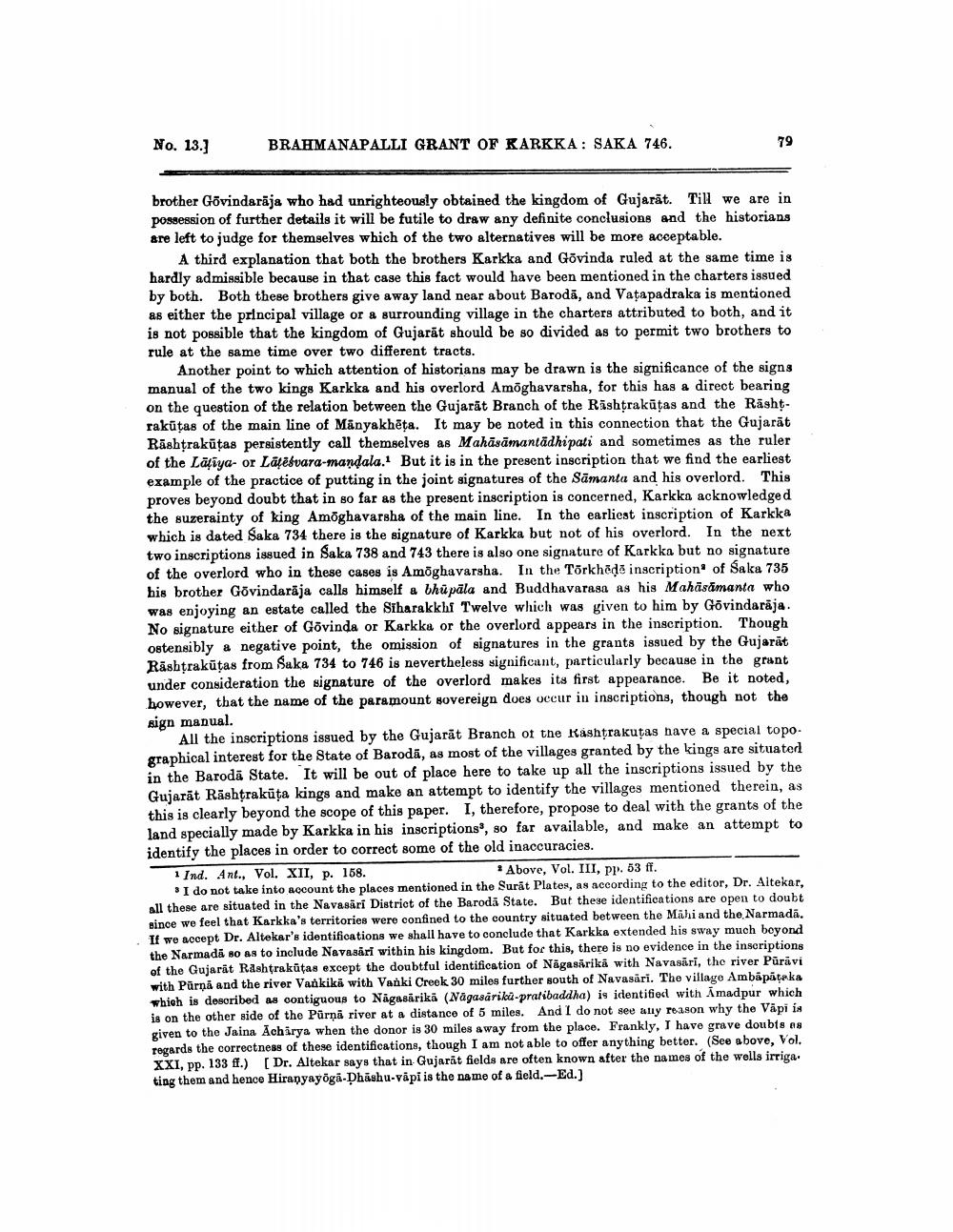________________
No. 13.
BRAHMANAPALLI GRANT OF KARKKA: SAKA 746.
brother Govindaraja who had unrighteously obtained the kingdom of Gujarat. Till we are in possession of further details it will be futile to draw any definite conclusions and the historians are left to judge for themselves which of the two alternatives will be more acceptable.
A third explanation that both the brothers Karkka and Govinda ruled at the same time is hardly admissible because in that case this fact would have been mentioned in the charters issued by both. Both these brothers give away land near about Barodā, and Vatapadraka is mentioned as either the principal village or a surrounding village in the charters attributed to both, and it is not possible that the kingdom of Gujarat should be so divided as to permit two brothers to rule at the same time over two different tracts.
Another point to which attention of historians may be drawn is the significance of the signs manual of the two kings Karkka and his overlord Amoghavarsha, for this has a direct bearing on the question of the relation between the Gujarat Branch of the Rishțrakūtas and the Răshtrakūtas of the main line of Mänyakhēţa. It may be noted in this connection that the Gujarāt Rashtrakūtas persistently call themselves as Mahāsāmantadhipati and sometimes as the ruler of the Lāļiya- or Lāçēsvara-mandala. But it is in the present inscription that we find the earliest example of the practice of putting in the joint signatures of the Samanta and his overlord. This proves beyond doubt that in so far as the present inscription is concerned, Karkka acknowledged the suzerainty of king Amoghavarsha of the main line. In the earliest inscription of Karkka which is dated Saka 734 there is the signature of Karkka but not of his overlord. In the next two inscriptions issued in Saka 738 and 743 there is also one signature of Karkka but no signature of the overlord who in these cases is Amoghavarsha. In the Tõrkhoda inscription of Saka 735 his brother Govindarāja calls himself a bhūpāla and Buddhavarasa as his Mahāsāmanta who was enjoying an estate called the Siharakkhi Twelve which was given to him by Govindaraja. No signature either of Govinda or Karkka or the overlord appears in the inscription. Though ostensibly a negative point, the omission of signatures in the grants issued by the Gujarat Rashtrakūtas from Saka 734 to 746 is nevertheless significant, particularly because in the grant under consideration the signature of the overlord makes its first appearance. Be it noted, however, that the name of the paramount sovereign does occur in inscriptions, though not the sign manual.
All the inscriptions issued by the Gujarāt Branch of the Rashtrakutas have a special topo. graphical interest for the State of Baroda, as most of the villages granted by the kings are situated in the Baroda State. It will be out of place here to take up all the inscriptions issued by the Gujarat Rashtrakūta kings and make an attempt to identify the villages mentioned therein, as this is clearly beyond the scope of this paper. I, therefore, propose to deal with the grants of the land specially made by Karkka in his inscriptions', so far available, and make an attempt to identify the places in order to correct some of the old inaccuracies. 1 Ind. Ant., Vol. XII, p. 158.
. Above, Vol. III, P. 53 ff. "I do not take into account the places mentioned in the Surat Platos, as according to the editor, Dr. Altekar, all these are situated in the Navasari District of the Baroda State. But these identifications are open to doubt since we feel that Karkka's territories were confined to the country situated between the Mahi and the Narmada. If we accept Dr. Altekar's identifications we shall have to conclude that Karkka extended his sway much boyond the Narmada so as to include Navasari within his kingdom. But for this, there is no evidence in the inscriptions of the Gujarat Rashtrakūtas except the doubtful identification of Nagasirika with Navasari, the river Puravi with Pūrni and the river Vaakiki with Vanki Creek 30 miles further south of Navasári. The village Ambapāçaka which is desoribed as contiguous to Nagasarika (Nagasarikl-pralibaddha) is identified with Amadpur which is on the other side of the Purni river at a distance of 5 miles. And I do not see any reason why the Vapi in given to the Jaina Achirya when the donor is 30 miles away from the place. Frankly, I have grave doubts as regards the correctness of these identifications, though I am not able to offer anything better. (See above, Vol. XXI, pp. 133 ff.) [Dr. Altekar says that in Gujarat fields are often known after the names of the wells irriga. ting them and henco Hiranyayoga.Dhäshu-väpi is the name of a field.-Ed.)




